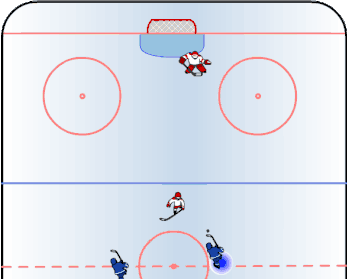
In ice hockey, a one-timer is a shot that occurs when a player meets a teammate's pass with an immediate slapshot, without any attempt to control the puck on their stick.[1] An effective one timer requires precise timing on the part of both players involved, especially the shooter. This play improves the shooter's chances at scoring a goal.[2] A wrist shot can also be done on a one-timer, though the puck is released far slower than a slapshot one-timer.
The effectiveness of the one-timer comes from three things:
- The angle from goal between the pass and the shot
- The change of direction of the puck
- The speed of the puck after the shot
Greater angle, change of direction and/or speed increases the chances of the puck going into the net. Lesser angle, change of direction and/or speed decreases the chance of the puck going into the net.
Either way, the one-timer enjoys a greater success rate than a one-on-one shot between shooter and goalie.
The reason it is called a one timer is that the player has only one time to connect.
References
- ↑ "What is a One-Timer? Hockey Shots Explained - BS Hockey". Retrieved 2022-07-27.
- ↑ Stimson, Ryan (2017-01-17). "Analyzing One-Timers: The Most Dangerous Shot in the Bag". Hockey Graphs. Retrieved 2022-07-27.